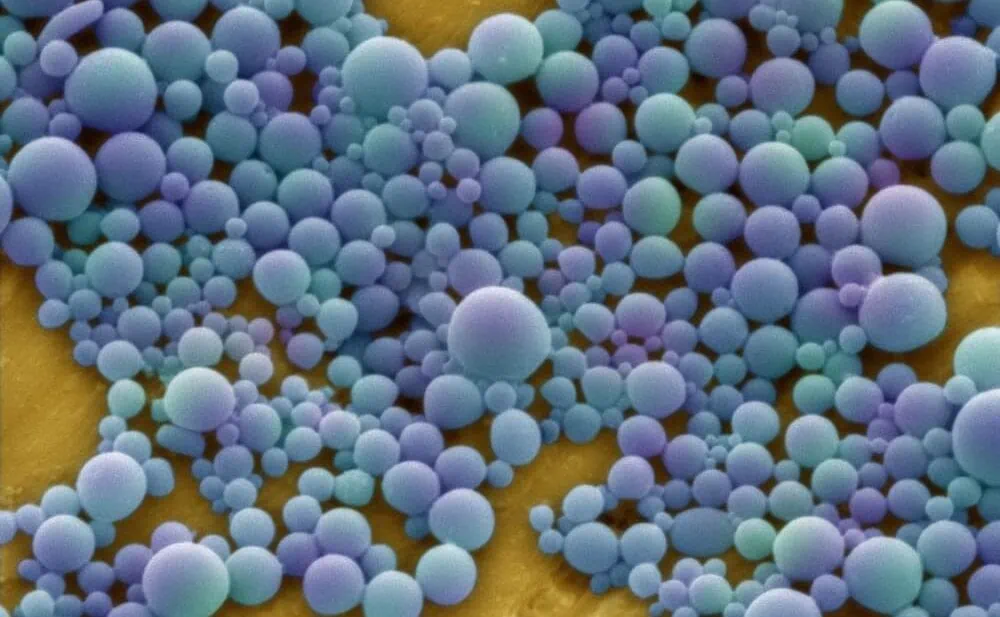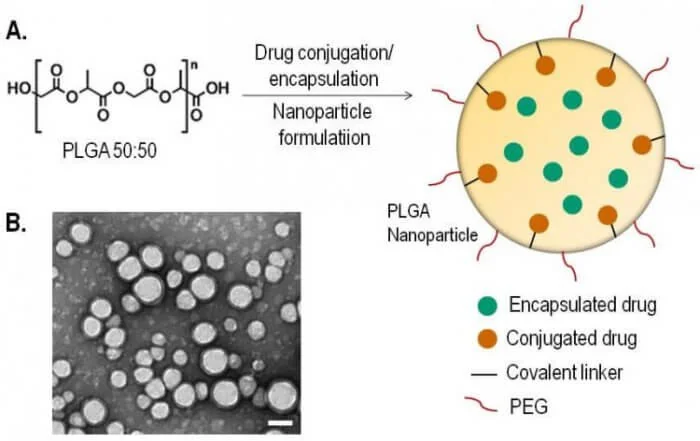Microfluidics Nanomaterial Synthesis Pack
Microfluidics for production of nanomaterials using sheath flow focusing
Efficient synthesis of nanomaterials
High throughput, monodispersity and reproducibility
Easy microfluidic system implementation
Unbox, set up and start your experiments right away
Biomedical applications
Synthesize nanomaterials like PLGA for drug delivery for example

Need a microfluidic SME partner for your Horizon Europe project?
Nanparticle synthesis with sheath flow drawing by Lababidi et al. (2019) Adapted nanoparticle image from Annie Cavanagh (welcome collection CC BY 4.0)
Microfluidics nanomaterial synthesis
The microfluidics nanomaterial synthesis Pack includes all the microfluidic parts (instruments and microchannels) for synthesizing nanomaterials by flow focusing with good monodispersity, throughput, and reproducibility. This pack has synthesized poly(lactic-co-glycolic acid) (PLGA) nanoparticles with a monodispersed diameter smaller than 200 µm.
Based on a fast and accurate flow controller and sheath flow microfluidic chips, this solution reduces synthesis time and reagent consumption compared to bulk experiments.
A standard microfluidics nanomaterial synthesis pack contains two pumping channels to push the two chemical solutions needed for nanomaterial synthesis using a hydrodynamic flow focus. This sheath flow synthesis allows controlled nanoprecipitation.
The stability and the kinetics of the reaction directly depend on the flow rates of each fluid in the microfluidic channel. Have you never performed a microfluidic experiment? Our experts will offer technical support to develop the microfluidic platform to synthesize your first nanomaterial.
Microfluidic nanoprecipitation enables a good throughput, monodispersity with tunable particle size, and, generally, better control of the nanomaterial synthesis.
Microfluidics nanomaterial synthesis pack setup
An all-in-one pack guarantees a good compatibility between the different componentes, allows a plug-and-play approach, is controlled by a single customizable software and can be used for other different experiments. These are a few arguments why a pack is the easiest way to setup a microfluidic experiment and is perfect for beginner and expert users.

Setup
Flow sensor (Galileo, MIC)
Software (Galileo user interface)
Flow controller
Reservoirs
Every chemicals needed for microfluidics nanomaterial synthesis
Microfluidic chip from microfluidic ChipShop
All necessary accessories: tubing, connectors, filters, etc…
Microfluidics sheath continuous flow nanoprecipitation principle
It has been showed that microfluidics technology can be particularly useful for synthesis of organic and inorganic nanoparticles with tunable shape and size [1]. A “bottom-up” nanomaterial formation approach that you can implement with this Pack is generally composed of three stages: nucleation of nanomaterials that consists of polymeric monomers, nuclei growth by aggregation of more monomers and finally an equilibrium is reached [2-3]. The synthesis has a better yield and has a better tunability in microfluidics than in bulk synthesis [4-5].
In the case of poly(lactic-co-glycolic acid) (PLGA) nanoprecipitation, PLGA monomers dissolved in an organic solvent and injected in the middle channel of the junction. Water mixed with surfactant is injected in the sheath flow channels to focus the PLGA fluid stream. A concentration gradient is formed by diffusion and the PLGA nanoparticles precipitate as this molecule is not soluble in water [6].
Other nanomaterials have also been synthesized using microfluidic technology like metal nanoparticles for surface plasmon resonance (SPR) applications [7]. Polydiacetylene nanomaterials have also been successfully obtained with this kind of setup [8].

Advantages of microfluidics for nanomaterial production

A microfluidic platform to synthesize nanomaterials is an excellent way to reduce the nanomaterial’s diameter dispersity thanks to finely tuned fluid properties and reactions. High-speed kinetics is also possible, which is essential for crystallization and precipitation processes to synthesize polymeric nanomaterials, for example.
Furthermore, using microfluidics is a way to decrease the amount of potentially valuable samples needed for the synthesis.
To summarize, nanomaterial synthesis is more effective in microfluidic than bulk synthesis regarding time, yield and dispersity.
Since microfluidic chips are miniaturized, it is possible to implement this nanomaterial synthesis part in a more complex experiment platform to perform complicated and multifunctional integrated process.
References
Ma, Junping, et al. “Controllable synthesis of functional nanoparticles by microfluidic platforms for biomedical applications–a review.” Lab on a Chip 17.2 (2017): 209-226.
Karnik, Rohit, et al. “Microfluidic platform for controlled synthesis of polymeric nanoparticles.” Nano letters 8.9 (2008): 2906-2912.
Lababidi, Nashrawan, et al. “Microfluidics as tool to prepare size-tunable PLGA nanoparticles with high curcumin encapsulation for efficient mucus penetration.” Beilstein Journal of Nanotechnology 10.1 (2019): 2280-2293.
Visaveliya, Nikunjkumar, and J. Michael Köhler. “Single-step microfluidic synthesis of various nonspherical polymer nanoparticles via in situ assembling: dominating role of polyelectrolytes molecules.” ACS Applied Materials & Interfaces 6.14 (2014): 11254-11264.
Song, Yujun, Josef Hormes, and Challa SSR Kumar. “Microfluidic synthesis of nanomaterials.” small 4.6 (2008): 698-711.
Donno, Roberto, et al. “Nanomanufacturing through microfluidic-assisted nanoprecipitation: Advanced analytics and structure-activity relationships.” International Journal of Pharmaceutics 534.1-2 (2017): 97-107.
Boken, J., D. Kumar, and S. Dalela. “Synthesis of nanoparticles for plasmonics applications: A microfluidic approach.” Synthesis and Reactivity in Inorganic, Metal-Organic, and Nano-Metal Chemistry 45.8 (2015): 1211-1223.
Baek, Sunghoon, et al. “Nanoscale diameter control of sensory polydiacetylene nanoparticles on microfluidic chip for enhanced fluorescence signal.” Sensors and Actuators B: Chemical 230 (2016): 623-629.
Banerjee, Deboshri, Rania Harfouche, and Shiladitya Sengupta. “Nanotechnology-mediated targeting of tumor angiogenesis.” Vascular cell 3 (2011): 1-13.
Customize your pack
This pack is highly customizable. Different microfluidic chips can be adapted for nanomaterial synthesis, such as a chip with a more extended channel after the junction for the chemical reaction to have more space.
The sheath flow cell sorting chips from Microfluidic ChipShop are available in poly(methyl methacrylate) (PMMA) or Cyclo Olefin Copolymer (COP) materials. These materials are optically transparent and compatible with most nanomaterial synthesis protocols. Different channel depths are also available.
The pack can be expanded with more pumping channels with various pressure ranges (positive or negative) for the flow control pump and flow rate sensors.
Contact our experts for any questions about this nanomaterial synthesis pack and how it can match your specifications.
Frequently asked questions
How can we help your experiment
This pack is in beta testing phase. So, although the instruments are not fully industrialized, we can provide extensive support as part of our beta testing program. Get in touch to see if you are eligible.
Can a pack be customized?
Yes! Our experts will establish which instruments are best suited for your application, such as the type of flow sensor or the number of flow controller channels you need to perform your experiment. Contact us using the “talk to our experts” green button above.
Can I buy individual instruments?
Our instruments are in beta testing phase and can be tested as a pack or individually, so get in contact with our team to know how our beta testing program works.

